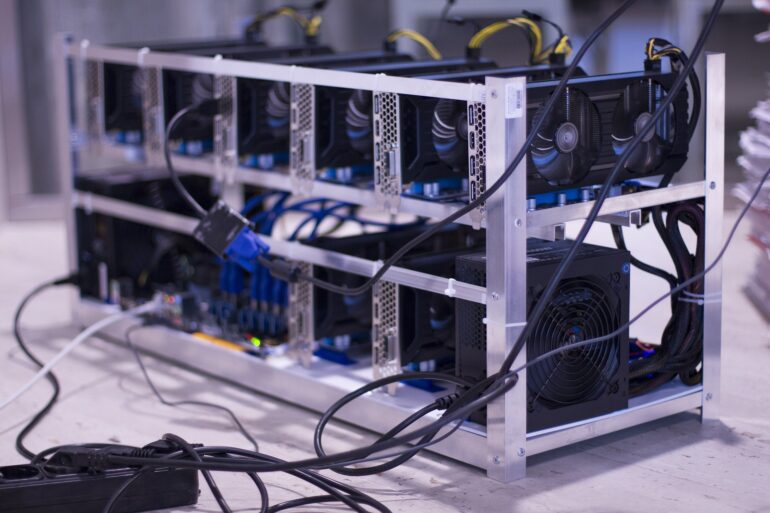TL;DR:
- Cryptocurrency mining companies are exploring the repurposing of idle GPUs for the booming HPC and AI markets.
- Hive Blockchain successfully tested repurposing its 38,000 Nvidia GPUs for high-performance computing and AI applications.
- GPUs used for mining can generate more revenue by running AI or cloud operations.
- Ethereum’s shift to the proof-of-stake model reduced the need for GPUs in mining, prompting companies to seek alternative uses for their hardware.
- The general-purpose nature of GPUs makes them valuable assets in the AI market, where Nvidia’s latest GPUs face supply shortages.
- Sysorex, a government services company, is considering alternative uses and sales opportunities for its 12,000 GPUs.
- Major chip manufacturers adjusted strategies to prioritize gamers over miners due to revenue fluctuations caused by GPU demand from mining companies.
- The scarcity of GPUs and reliance on Nvidia GPUs for AI computing is driving customers to explore alternative chip sources.
Main AI News:
The cryptocurrency boom brought a surge in demand for GPUs, as mining companies eagerly sought powerful hardware to fuel their operations. However, the recent market crash has left these companies with a dilemma: what should they do with their idle GPUs? Now, they are exploring the possibility of repurposing these graphics processing units for the thriving high-performance computing (HPC) and artificial intelligence (AI) markets.
One such company is Hive Blockchain, which currently possesses a staggering 38,000 Nvidia GPUs. In the wake of the crypto market crash, Hive found itself reevaluating the future of its GPU fleet. Traditionally used for mining popular cryptocurrencies like Bitcoin and Ethereum, these GPUs suddenly became less profitable. However, Hive quickly recognized the potential of redirecting its hardware toward HPC and AI applications.
To test this strategy, Hive launched a pilot program that allocated its GPUs to AI and high-performance computing tasks. The results were impressive, with the beta project generating a revenue of $230,000 this quarter using only around 500 GPU cards. Frank Holmes, the executive chairman of Hive, expressed his satisfaction with the outcome and acknowledged the company’s ambitious goals of fully utilizing its GPU resources.
Hive’s experience reflects a broader trend among crypto companies. They are realizing that GPUs possess immense potential to generate revenue by powering AI and cloud operations. In a market where cryptocurrencies are experiencing significant volatility, these companies are seeking stability and profitability by diversifying their applications. By tapping into the burgeoning AI sector, they can leverage their GPU assets to meet the surging demand for high-performance computing.
The shift away from GPU-intensive mining practices has been driven by various factors. Ethereum’s transition from the proof-of-work to the proof-of-stake model significantly reduced the need for powerful GPUs. This change aimed to mitigate the environmental impact of mining by decreasing energy consumption. As a result, the reliance on GPUs for mining coins decreased, leaving mining companies searching for new opportunities.
While other GPUs may face challenges in the current market, Hive’s older Nvidia GPUs remain highly sought-after for AI inference tasks. The general-purpose nature of these GPUs positions them as valuable assets in the AI market, where Nvidia’s latest GPUs are facing supply shortages. As the demand for AI accelerates, Hive’s GPU fleet could find new life in providing the computational power required for AI algorithms and data processing.
Sysorex, a government services company, is also grappling with the fate of its 12,000 GPUs in the aftermath of Ethereum’s software model switch. The company’s subsidiary, TTM, which focused on cryptocurrencies, left the mining business behind. Uncertain about the next steps, Sysorex acknowledged the broken nature of the cryptocurrency business model. Repurposing the GPUs for alternative applications would demand substantial upfront investments in data centers, making it an unfeasible option for now.
The changing dynamics of the GPU market have not only impacted mining companies but also affected major chip manufacturers like Nvidia, AMD, and Intel. These companies experienced unpredictable revenue fluctuations as crypto miners flocked to purchase their GPUs, causing supply shortages and complicating sales projections. To address this, the chip makers adjusted their strategies to prioritize gamers as the primary audience and deter miners. Intel even discontinued its Bitcoin ASIC, BlockScale, earlier this year.
Furthermore, the scarcity of GPUs and the heavy reliance on Nvidia GPUs for AI computing has compelled customers to explore alternative chip sources. Intel and AMD have entered the GPU market for AI applications, but large-scale shipments are yet to materialize. AI’s trajectory is increasingly favoring large-language models such as OpenAI’s ChatGPT and Microsoft’s BingGPT, which heavily rely on GPU-laden clusters. However, open-source developers and companies like MosaicML are introducing models that can run locally on laptops and desktops for inference computing. Intel has also responded by integrating AI accelerators into its new CPUs, delivering efficient inference processing.
Conclusion:
The repurposing of idle GPUs by mining companies for the HPC and AI markets signifies a significant shift in their business strategies. Recognizing the declining profitability of mining cryptocurrencies, these companies are seeking new avenues for revenue generation. By repurposing their idle GPU resources, they can tap into the growing demand for computational power in AI applications. This trend also highlights the need for alternative chip sources and the impact of GPU scarcity on the market. As mining companies adapt to these changing dynamics, the market is witnessing a convergence of interests between the cryptocurrency, HPC, and AI sectors.

